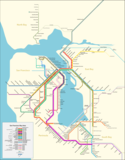The 2021 American Community Survey confirms that major population shifts took place due to the pandemic. But those shifts aren’t necessarily reflected by declines in housing prices read more »
Demographics
Marilyn and Elvis: Dead Labor in the Age of Streaming
When Marilyn Monroe was cast as a spunky cannery worker in Clash by Night (1952), she took “an all-night bus to Monterey to observe cannery workers and to practice being working class.” As biographer Lois Banner noted, she was even offered a job, cutting off the heads of sardines. But Marilyn was already familiar with factory work. read more »
- Login to post comments
The "Tottering Chicago?" Series – Part 3
Here’s part 3 in the “Tottering Chicago?” series. Today I’m discussing the third question I raised after reading William Voegeli’s That Tottering Town, a review of the book What Next, Chicago? read more »
- Login to post comments
U.S. Auto Commuting Dips to Half Century Low
The share of workers commuting to work by auto fell to 75.6%, according to the 2021 American Community Survey (ACS), the lowest level since before the 1970 census, which reported that 77.7% of commuting was by auto (Figure 1). read more »
The Geography of Superentrepreneurs
What parts of the world have given rise to the most successful entrepreneurs? This is a question which is answered in the superentrepreneurs project. This project is about studying high-end entrepreneurship read more »
Ghana: Sub-Saharan Fertility Case Study
Sub-Saharan Africa has grown quickly, at a rate about 1.5 times the rest of the world from 1960 to 2020. This has principally been the result of its higher fertility rates and increasing life expectancy. read more »
Fertility in Canada’s Provinces and Metropolitan Areas: 2020
Canada, like virtually all regions classified as “more developed” by the United Nations (Europe, Canada, the United States, Japan, Australia and New Zealand) is experiencing a dropping birth rate. read more »
- Login to post comments
Class Homicide
There’s much talk today, from left and right, about threats to democracy, yet little focus on the social dynamic critical to its survival. In this respect, we may see the current, and troubling, escalation of violent political rhetoric, and even political violence, not so much as the cause of polarization but the result of changing class dynamics, most notably the increasingly perilous state of the yeoman middle class. read more »
- Login to post comments
Is Pro-Life Bad for Business?
Shortly after Indiana passed a new law restricting abortion, Indianapolis-based pharmaceutical giant Eli Lilly condemned the law and announced that it would seek to expand outside the state. read more »
- Login to post comments
There Are Dark Days Ahead for the Jewish Diaspora
Jews around the world, particularly outside the fortress of Israel, are threatened in a way not seen since the 1940s. A fundamentally unstable world, with rising class and racial animus, creates a perilous environment for history’s favourite target, as seen previously in such periods as the fall of Rome, the Crusades, the Black Death and the Great Depression of the 1930s. read more »
- Login to post comments






















